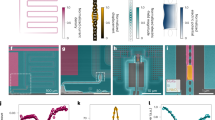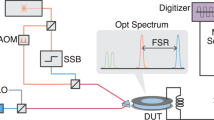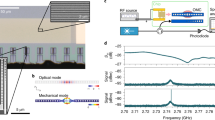Abstract
Quantum transducers that can convert quantum signals from the microwave to the optical domain are a crucial optical interface for quantum information technology. Coherent microwave-to-optics conversions have been realized with various physical platforms, but all of them are limited to low efficiencies of less than 50%—the threshold of the no-cloning quantum regime. Here we report coherent microwave-to-optics transduction using Rydberg atoms and off-resonant scattering technique with an efficiency of 82 ± 2% and a bandwidth of about 1 MHz. The high conversion efficiency is maintained for microwave photons ranging from thousands to about 50, suggesting that our transduction is readily applicable to the single-photon level. Without requiring cavities or aggressive cooling for the quantum ground states, our results would push atomic transducers closer to practical applications in quantum technologies.
This is a preview of subscription content, access via your institution
Access options
Access Nature and 54 other Nature Portfolio journals
Get Nature+, our best-value online-access subscription
$29.99 / 30 days
cancel any time
Subscribe to this journal
Receive 12 print issues and online access
$209.00 per year
only $17.42 per issue
Buy this article
- Purchase on Springer Link
- Instant access to full article PDF
Prices may be subject to local taxes which are calculated during checkout



Similar content being viewed by others
Data availability
The data supporting the results in this study are available within the paper and Supplementary Information. The raw datasets generated during the study are too large to be publicly shared, but they are available from the corresponding authors upon reasonable request.
Code availability
The codes used for the theoretical simulations are available from the corresponding authors upon reasonable request.
References
Kimble, H. J. The quantum internet. Nature 453, 1023–1030 (2008).
Wehner, S., Elkouss, D. & Hanson, R. Quantum internet: a vision for the road ahead. Science 362, eaam9288 (2018).
O’Brien, J. L., Furusawa, A. & Vuckovic, J. Photonic quantum technologies. Nat. Photon. 3, 687–695 (2009).
Lvovsky, A. I., Sanders, B. C. & Tittel, W. Optical quantum memory. Nat. Photon. 3, 706–714 (2009).
Xiang, Z. L. et al. Hybrid quantum circuits: superconducting circuits interacting with other quantum systems. Rev. Mod. Phys. 85, 623 (2013).
Lambert, N. J. et al. Coherent conversion between microwave and optical photons—an overview of physical implementations. Adv. Quantum Technol. 3, 1900077 (2020).
Lauk, N. et al. Perspectives on quantum transduction. Quantum Sci. Technol. 5, 020501 (2020).
Wolf, M. M., Pérez-García, D. & Giedke, G. Quantum capacities of bosonic channels. Phys. Rev. Lett. 98, 130501 (2007).
Grosshans, F. & Grangier, P. Quantum cloning and teleportation criteria for continuous quantum variables. Phys. Rev. A 64, 010301 (2001).
Rueda, A. et al. Efficient microwave to optical photon conversion: an electro-optical realization. Optica 3, 597–604 (2016).
Fan, L. et al. Superconducting cavity electro-optics: a platform for coherent photon conversion between superconducting and photonic circuits. Sci. Adv. 4, eaar4994 (2018).
Witmer, J. D. et al. A silicon-organic hybrid platform for quantum microwave-to-optical transduction. Quantum Sci. Technol. 5, 034004 (2020).
Bochmann, J., Vainsencher, A., Awschalom, D. D. & Cleland, A. N. Nanomechanical coupling between microwave and optical photons. Nat. Phys. 9, 712–716 (2013).
Andrews, R. W. et al. Bidirectional and efficient conversion between microwave and optical light. Nat. Phys. 10, 321–326 (2014).
Higginbotham, A. et al. Harnessing electro-optic correlations in an efficient mechanical converter. Nat. Phys. 14, 1038–1042 (2018).
Forsch, M. et al. Microwave-to-optics conversion using a mechanical oscillator in its quantum ground state. Nat. Phys. 16, 69–74 (2019).
Wu, M. et al. Microwave-to-optical transduction using a mechanical supermode for coupling piezoelectric and optomechanical resonators. Phys. Rev. Appl. 13, 014027 (2020).
Jiang, W. et al. Efficient bidirectional piezo-optomechanical transduction between microwave and optical frequency. Nat. Commun. 11, 1166 (2020).
Williamson, L. A., Chen, Y. H. & Longdell, J. J. Magneto-optic modulator with unit quantum efficiency. Phys. Rev. Lett. 113, 203601 (2014).
O’Brien, C. et al. Interfacing superconducting qubits and telecom photons via a rare-earth-doped crystal. Phys. Rev. Lett. 113, 063603 (2014).
Hisatomi, R. et al. Bidirectional conversion between microwave and light via ferromagnetic magnons. Phys. Rev. B 93, 174427 (2016).
Welinski, S. et al. Electron spin coherence in optically excited states of rare-earth ions for microwave to optical quantum transducers. Phys. Rev. Lett. 122, 247401 (2019).
Gonzalvo, F. X. et al. Cavity-enhanced Raman heterodyne spectroscopy in Er3+: Y2SiO5 for microwave to optical signal conversion. Phys. Rev. A 100, 033807 (2019).
Bartholomew, J. G. et al. On-chip coherent microwave-to-optical transduction mediated by ytterbium in YVO4. Nat. Commun. 11, 3266 (2020).
Kiffner, M. et al. Two-way interconversion of millimeter-wave and optical fields in Rydberg gases. New J. Phys. 18, 093030 (2016).
Han, J. et al. Coherent microwave-to-optical conversion via six-wave mixing in Rydberg atoms. Phys. Rev. Lett. 120, 093201 (2018).
Covey, J. P. et al. Microwave-to-optical conversion via four-wave mixing in a cold ytterbium ensemble. Phys. Rev. A 100, 012307 (2019).
Zibrov, A. S., Matsko, A. B. & Scully, M. O. Four-wave mixing of optical and microwave fields. Phys. Rev. Lett. 89, 103601 (2002).
Petrosyan, D. et al. Microwave to optical conversion with atoms on a superconducting chip. New J. Phys. 21, 073033 (2020).
Petrosyan, D. et al. Reversible state transfer between superconducting qubits and atomic ensembles. Phys. Rev. A 79, 040304(R) (2009).
Vogt, T. et al. Efficient microwave-to-optical conversion using Rydberg atoms. Phys. Rev. A 99, 023832 (2019).
Merriam, A. et al. Efficient nonlinear frequency conversion in an all-resonant double-Λ system. Phys. Rev. Lett. 84, 5308 (2000).
Jain, M. et al. Efficient nonlinear frequency conversion with maximal atomic coherence. Phys. Rev. Lett. 77, 4326 (1996).
Wang, Y. et al. Efficient quantum memory for single-photon polarization qubits. Nat. Photon. 13, 346–351 (2019).
Liao, K. Y. et al. Microwave electrometry via electromagnetically induced absorption in cold Rydberg atoms. Phys. Rev. A 101, 053432 (2020).
Šibalić, N. et al. ARC: an open-source library for calculating properties of alkali Rydberg atoms. Comput. Phys. Comm. 220, 319–331 (2017).
Fleischhauer, M., Imamoglu, A. & Marangos, J. P. Electromagnetically induced transparency: optics in coherent media. Rev. Mod. Phys. 77, 633 (2005).
Hogan, S. D. et al. Driving Rydberg-Rydberg transitions from a coplanar microwave waveguide. Phys. Rev. Lett. 108, 063004 (2012).
Hermann-Avigliano, C. et al. Long coherence times for Rydberg qubits on a superconducting atom chip. Phys. Rev. A 90, 040502 (2014).
Morgan, A. A. & Hogan, S. D. Coupling Rydberg atoms to microwave fields in a superconducting coplanar waveguide resonator. Phys. Rev. Lett. 124, 193604 (2020).
Kaiser, M. et al. Cavity driven Rabi oscillations between Rydberg states of atoms trapped on a superconducting atom chip. Preprint at https://arxiv.org/abs/2105.05188 (2021).
Bagci, T. et al. Optical detection of radio waves through a nanomechanical transducer. Nature 507, 81–85 (2014).
Gard, B. et al. Microwave-to-optical frequency conversion using a cesium atom coupled to a superconducting resonator. Phys. Rev. A 96, 013833 (2017).
Mirhosseini, M. et al. Superconducting qubit to optical photon transduction. Nature 588, 599–603 (2020).
Mack, M. et al. Measurement of absolute transition frequencies of 87Rb to nS and nD Rydberg states by means of electromagnetically induced transparency. Phys. Rev. A 83, 052515 (2011).
Gordon, J. A. et al. Millimeter wave detection via Autler-Townes splitting in rubidium Rydberg atoms. Appl. Phys. Lett. 105, 024104 (2014).
Acknowledgements
We thank T. Vogt, W. Li, J. Han and W. Li for useful discussions. The work was supported by the Key Area Research and Development Program of Guangdong province (grant nos. 2019B030330001 (S.-L.Z., H.Y., K.-Y.L. and X.-D.Z.) and 2020B0301030008 (H.Y.)); the National Natural Science Foundation of China (grant nos. 91636218 (S.-L.Z., H.Y. and K.-Y.L.), 11804104 (K.-Y.L.), 11822403 (H.Y.), 61875060 (X.-D.Z.), U1801661 (S.-L.Z. and H.Y.) and U20A2074 (H.Y.)); the Key Project of Science and Technology of Guangzhou (grant nos. 201902020002 (X.-D.Z.) and 2019050001 (S.-L.Z. and H.Y.)); and the National Key Research and Development Program of China (grant no. 2020YFA0309500 (Z.-X.Z.)).
Author information
Authors and Affiliations
Contributions
K.-Y.L. and H.Y. designed the experiment. H.-T.T., Z.-X.Z, X.-H.L. and S.-Z.Y. carried out the experiments. H.-T.T., K.-Y.L., S.-Y.Z. and X.-D.Z. conducted the raw-data analysis. K.-Y.L., H.Y. and S.-L.Z. wrote the paper, and all the authors discussed the paper’s contents. H.Y. and S.-L.Z. supervised the project.
Corresponding authors
Ethics declarations
Competing interests
The authors declare no competing interests.
Peer review
Peer review information
Nature Photonics thanks Jacob Covey and the other, anonymous, reviewer(s) for their contribution to the peer review of this work.
Additional information
Publisher’s note Springer Nature remains neutral with regard to jurisdictional claims in published maps and institutional affiliations.
Supplementary information
Supplementary Information
Supplementary Sections I–VI and Figs. 1–4.
Rights and permissions
About this article
Cite this article
Tu, HT., Liao, KY., Zhang, ZX. et al. High-efficiency coherent microwave-to-optics conversion via off-resonant scattering. Nat. Photon. 16, 291–296 (2022). https://doi.org/10.1038/s41566-022-00959-3
Received:
Accepted:
Published:
Issue Date:
DOI: https://doi.org/10.1038/s41566-022-00959-3
This article is cited by
-
Ambient microwave-to-optical converter
Nature Photonics (2024)
-
Universal control of a bosonic mode via drive-activated native cubic interactions
Nature Communications (2024)
-
Continuous wideband microwave-to-optical converter based on room-temperature Rydberg atoms
Nature Photonics (2024)
-
Quantum-enabled millimetre wave to optical transduction using neutral atoms
Nature (2023)
-
Coherent optical control of a superconducting microwave cavity via electro-optical dynamical back-action
Nature Communications (2023)



